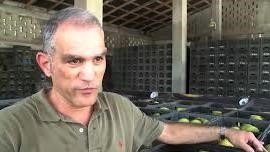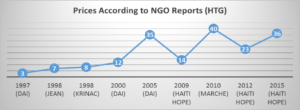This article summarizes how USG funded aid agencies and contractors have manipulated price data to make it appear that they have improved the export market chain price for mangoes. As seen below, they’ve rather boldly misrepresented their own data to make their case.
Lying Sack of Mango: Travesty of Export Prices

In 2005, USAID-funded HAP (Hillside Agricultural Project, 200-2007) claimed that,
Field interviews indicated that ten years ago producers were paid four gourdes for a dozen mangos, and a “dozen” was defined as 18 to 20 fruits. Currently, producers have been receiving 35 gourdes per dozen with the dozen defined as 14 fruits. HAP technical assistance and training in producer harvest and handling significantly reduced export factory rejects, and therefore also reduced the exporter’s need to “discount” the number in a dozen. (HAP 2005; p 6).
This claim was one of many such claims made over the past 20 years about progress in the Mango sector and helping Haitians get better prices, something that is, at best, questionable. At worst, its another example of outright lies intended to dupe the public and politicians in developed countries into supporting organizations that thrive off of development funds while delivering ineffective and often non-existent services to the poor. The misuse of data is so extreme in this case that the projects themselves had to contradict one another’s data to make their own appear project appear successful. Here are the details,
- In 2000, at the onset of USAID funded HAP (Hillside Agricultural Project), DAI (the implementing agency) wrote a baseline report on Francique Mangos in which it stated that farm gate prices for Francique in Jacmel, Leogane, or Cabaret were 12-17 HTG per dozen, translating to US$0.63 to $0.89 cents per “dozen” of 15 to 21 mangos. DAI reported that elsewhere prices varied from 5 to 17 HTG, translating to from US$0.26 to $0.89 per dozen with a mid-point of $0.58.
- In 2005, five years into the HAP project, DAI took credit for raising farm gate prices in the Artibonite Valley and Plateau Central by 17 percent. To do so they did a little revising, saying that the price rose from “3 – 4 HTG per dozen in 1997-1998” to 35 HTG per dozen in 2005. In effect, DAI claimed a new cooperative price of US$0.97. But if what they claimed had been true, they would have raised farm-gate prices not 17% but by a local currency factor of 10x, and a USD currency factor of more than triple what they claimed in 1997-98, and almost double the claimed price in 2000
- Five years later, in 2010, when beginning the Coca Cola/USAID/IDB-funded and TechnoServe-implemented Haiti Hope project used information from 3,299 farmers to estimate the price for export quality mangos at 20 HTG ($0.51) and conventional local Francique at 8 HTG ($0.20), an average of US $0.36. In local currency that’s 57% of the price HAP report five years earlier (TNS). If we calculate in USD it’s about half the price. In other words, either TechnoServe is contradicting HAP to the tune of 1/2 the claimed HAP price or the price of Mangos fell in half over the period of time, something we know did not happen.
- In the same year, 2010, the USAID-funded MarChE report (page 16) cited an average price paid to grower cooperatives for Francique mangos of 40 HTG per dozen or, at that time, which is US $0.98. That prices was for non-organic certified mangoes. In both HTG and USD, that’s three times the price that TechnoServe was reporting for the same year. The same report noted that non-organic mangos were wholesaling on the local market for US$1.00-.$1.25 (40 -50 HTG), 25% more than the MarChE reported export chain price.2
- In 2014 USAID/WINNER added to the prevarication telling interested visitors to their website that until “the mid-1990’s, the Francique mango did not have much value in the marketplace and was sold for a very low price (between 3 and 9 gourdes a dozen)”. The punch line—if there is one– is that that the value of the gourde varied during the 1990s from 8 to 18 gourde to one US dollar and then in 2003 it shot up to 40 HTG per 1 USD where it remained until 2012, hitting 45 in 2014. So the variation of 3 to 9 gourde would mean that, in US Dollars, a dozen mangos was generally fetching the same price in the 1990s as they did in 2012, 2014 and 2015, at the height of USAID/WINNER’s own mango project and the Haiti Hope Project. Indeed, when all is said and done, all these claims about increasing value of the Mango can be explained by changing value of the US dollar. For anyone that doesn’t believe that the Haitian economy tracks the US dollar, consider that Haiti is dependent on the US for at least 55 percent of food stuffs and more than 80 percent of durable goods. If you want to know more, read this.


Lest anyone think that Haiti HOPE and Coca Cola, USAID, IDB, DAI, and TechnoServe are the only organizations inclined to twist mango price data to make it appear they assisted impoverished Haitian agricultural producers to get better prices for their fruit, here is a list organizations and citations making very similar bogus claims about mango prices, percentage of rejects and size of dozens, and in much the same language as USAID, IDB, Coca Cola, DAI, and IDB,
- AVSF (Agronomist and veterinary without Borders; see AVSF, undated)
- ORE (http://www.oreworld.org/)
- Mercy Corps (see TaiwanICDF 2012)
- Chemonics (USAID/Winner 2014a)
- OXFAM (2014; see Fuller-Wimbush, Danielle and Cardyn Fils-Aimé 2014)
- IICA, Concern and the EU (see EU 2014)
- ID (Initiative Developpment with ADEMA; see ID 2015)
- World Vision (undated but after 2010)
WORKS CITED
AVSF (undated) http://www.avsf.org/es/posts/1151/full/Mango_de_calidad_en_el_Centro_de_Haiti
EU (2014) Evaluation de la coopération de l’Union européenne avec la République d’Haïti Rapport final Volume II Août 2014
Fuller-Wimbush, Danielle and Cardyn Fils-Aimé 2014 Feed the Future Investment in Haiti:Implications for sustainable food security and poverty reduction. OXFAM, America
Fuller-Wimbush, Danielle and Cardyn Fils-Aimé 2014 Feed the Future Investment in Haiti: Implications for sustainable food security and poverty Reduction. OXFAM AMERICA RESEARCH BACKGROUNDER
ID (2015) (with ADEMA) Initiative Developpemnt: Programme Sécurité Alimentaire TdR Evaluation fin Programme, janvier 2015 Evaluation du programme : HAITI Janvier 2015 http://www.cliohaiti.org/annonces/annonce_030f0.pdf?PHPSESSID=0a2c48cf06c6ef4127977a680d47ec43
TaiwanICDF (International Cooperation and Development Fund) 2012 Appraisal of Haiti Post-Harvest Loss Reduction Program TaiwanICDF March 2012
(for other references and more data see here)







